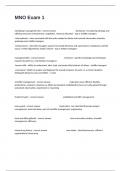MNO Exam 1
mintzberg's managerial roles - correct answer -decisional - for planning strategy and
utilizing resources (entrepreneur, negotiator, resource allocator) - top or middle managers
-informational - roles associated with the tasks needed to obtain and transmit information (monitor,
spokesperson) middle managers
-interpersonal - roles that managers assume to provide direction and supervision to employees and the
org as a whole (figurehead, leader, liaison) - top or bottom managers
managerial skills - correct answer -technical - specific knowledge and techniques
required to perform a role (bottom managers)
-human stills - ability to understand, alter, lead, and control the behavior of others - middle managers
-conceptual - ability to analyze and diagnose the overall company, its parts, or a certain situation;
distinguish between cause and effect - c-suite
scientific management - correct answer make jobs more efficient, flexible,
productivity, conducts a business or affairs by standards established by facts or truths gained through
systematic observation, experiment or reasoning
frederick taylor - correct answer established scientific management
henry gantt - correct answer Gantt chart - bar chat that illustrates project
management, start/end dates, part of scientific management, engineering
frank and lillian gilbreth - correct answer time and motion studies, scientific
management, efficiency
classical org theory - correct answer max weber - ideal bureaucracy, efficient
organizational structuring
,human relations movement - correct answer management philosophy that rejected
the primarily economic orientation of scientific management and focused instead on the noneconomic,
social factors operating in the workplace, people work more efficiently when monitored
elton mayo - HRM, hawthorne studies, advised managers to attend to employees' emotional needs
mary parker follett - bottom up, empowerment, authority based on knowledge, not position, horizontal
view of power, motivate job performance instead of demanding it, "pull" rather than "push" strategy,
female consultant and for encouraging managers to motivate workers by involving them in decisions
and processes rather than by using force
Douglas McGregor - correct answer developed theory X vs. Theory Y, modern view
of people at work, formulated contrasting sets of assumptions about human nature
Theory X - correct answer outdated assumptions about people at work: people hate
work, people must be threatened with punishment before they will work, require close direction, avoid
responsibility, little ambition, only want security
Theory Y - correct answer modern assumptions about people at work, people view
work as neutral and are capable of self-direction and self-control, become committed to organizational
objectives if they are rewarded for doing so, typical employee can learn to accept and seek
responsibility, has creativity
Edward Deming - correct answer Total quality management, (85-15 rule) - good
management, reduction of variations in industrial processes, human side of quality improvement, formal
training, helpful leadership, elimination of error, emphasis on continuous process improvements,
teamwork, elimination of barriers
total quality management - correct answer get right the first time, learn from
customers and employees, make everyday improvements, build teamwork, trust, ad mutual respect
quality of the goods and services we purchase today is significantly better than in years past, orgs
culture is defined by and supports the constant attainment of customer satisfaction through an
integrated system of tools, techniques and training, involves continuous improvement of organizational
processes, employee driven
85-15 rule - correct answer 85% system at fault (management, machinery, rules),
15% individual employee fault
, six sigma - correct answer check product quality and eliminate unnecessary
elements of production, way of thinking about business problems that encourages precision and
predictability, no more than 6 standard deviations away from perfect measure
Peter Drucker - correct answer creating a customer should be your focus, 9
behaviors managers can focus on to improve their leadership effectiveness, provide knowledge leaders
need, help leaders convert knowledge into action, ensure whole org feels responsible and accountable
3 tasks of management (Peter Drucker) - correct answer Establish specific purpose
make work productive
manage social responsibilities
myers-briggs four preference pairs - correct answer extraversion vs. introversion
(focus of attention)
sensing vs. intuition (collect information)
thinking vs. feeling (process and evaluate information)
judging vs. perceiving (orient toward outer world)
Big Five definition - correct answer personality profile, one's personality profile
tends to be stable and durable, extraversion and conscientiousness most stable
Big Five characteristics - correct answer (OCEAN)
-openness to experience - intellectual, imaginative, curious, broad-minded
-conscientiousness - most robust predictor - dependable, responsible, achievement oriented, persistent
-extraversion - outgoing, talkative, sociable, assertive
-agreeableness - trusting, good-natured, cooperative, softhearted
-negative affectivity (emotional stability) - relaxed, secure, unworried
need for achievement - correct answer strong desire to perform challenging tasks
well and meet personal standards for excellence, tend to have higher stress and personal health
problems, could not follow rules to get to top, CEOs tend to have this, employees could quit




